
Buckingham Palace is a royal residence in London and the administrative headquarters of the monarch of the United Kingdom. Located in the City of Westminster, the palace is often at the centre of state occasions and royal hospitality. It has been a focal point for the British people at times of national rejoicing and mourning.
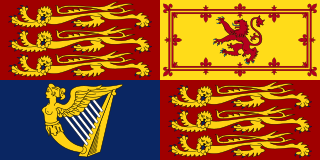
The Royal Standards of the United Kingdom presently refer to either of two similar flags used by King Charles III in his capacity as Sovereign of the United Kingdom, the Crown dependencies, and the British Overseas Territories. Two versions of the flag exist, one for use within Scotland and the other for use elsewhere.
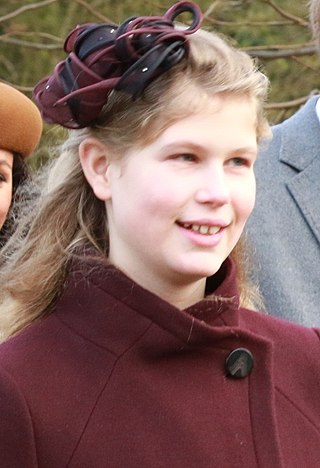
Lady Louise Alice Elizabeth Mary Mountbatten-Windsor is the daughter of Prince Edward, Duke of Edinburgh, and Sophie, Duchess of Edinburgh. She is the youngest niece of King Charles III. She was born 8th in line to the British throne and is now 16th as of 2023.
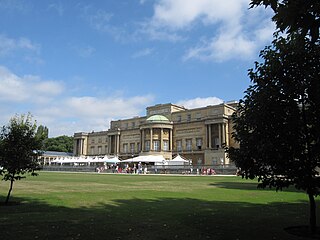
Buckingham Palace Garden is a large private park attached to the London residence of the British monarch. It is situated to the rear (west) of Buckingham Palace, occupying a 17-hectare (42-acre) site in the City of Westminster and forms the largest private garden in London. It is bounded by Constitution Hill to the north, Hyde Park Corner to the west, Grosvenor Place to the south-west, and the Royal Mews, Queen's Gallery, and Buckingham Palace itself to the south and east.
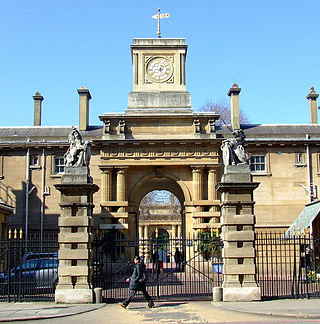
The Royal Mews is a mews, or collection of equestrian stables, of the British royal family. In London these stables and stable-hands' quarters have occupied two main sites in turn, being located at first on the north side of Charing Cross, and then within the grounds of Buckingham Palace.

The Coronation Chair, also known as St Edward's Chair or King Edward's Chair, is an ancient wooden chair on which British monarchs sit when they are invested with regalia and crowned at their coronations. It was commissioned in 1296 by King Edward I to contain the coronation stone of Scotland—known as the Stone of Destiny—which had been captured from the Scots. The chair was named after Edward the Confessor and was kept in his shrine at Westminster Abbey.

The Irish State Coach is an enclosed, four-horse-drawn carriage used by the British Royal Family. It is the traditional horse-drawn coach in which the British monarch travels from Buckingham Palace to the Palace of Westminster to formally open the new legislative session of the UK Parliament.

The Gold State Coach is an enclosed, eight-horse-drawn carriage used by the British royal family. Commissioned in 1760 by Francis Rawdon-Hastings, 1st Marquess of Hastings for King George III, and designed by Sir William Chambers, it was built in the London workshops of Samuel Butler. It was commissioned for £7,562. It was built for George III's coronation in 1761, but was not ready in time; it was completed in 1762.

The Silver Jubilee of Elizabeth II marked the 25th anniversary of the accession of Queen Elizabeth II on 6 February 1952. It was celebrated with large-scale parties and parades throughout the United Kingdom and the Commonwealth throughout 1977, culminating in June with the official "Jubilee Days", held to coincide with the Queen's Official Birthday. The anniversary date itself was commemorated in church services across the land on 6 February 1977, and continued to be for the rest of that month. In March, preparations started for large parties in every major city of the United Kingdom, as well as for smaller ones for countless individual streets throughout the country.

The King's Bargemaster is a subordinate officer of the Royal Household of the Sovereign of the United Kingdom. Until the mid-19th century, the Royal Family frequently used a royal barge for transport along the River Thames. The role of the King's Bargemaster was to oversee this. The tradition of the Bargemaster dates back to 1215, with the signing of Magna Carta at Runnymede. The role is now largely ceremonial.

The Scottish State Coach is an enclosed, four-horse-drawn carriage used by the British Royal Family.

James Alexander Philip Theo Mountbatten-Windsor, Earl of Wessex, is the younger child and son of Prince Edward, Duke of Edinburgh, and Sophie, Duchess of Edinburgh. He is the youngest grandchild of Queen Elizabeth II and Prince Philip, Duke of Edinburgh, and the youngest nephew of King Charles III. At the time of his birth, he was 8th in line to the British throne. As of 2023, he is 15th.

The Australian State Coach is an enclosed, six horse-drawn coach used by the British Royal Family. Constructed in 1986-88, it was the first royal state coach to have been built since 1902. It was presented to Queen Elizabeth II of Australia and the United Kingdom in Canberra on 8 May 1988, as the official gift on the occasion of the Australian Bicentennial, and was first used in November of that year by the Queen at the State Opening of Parliament in the UK.
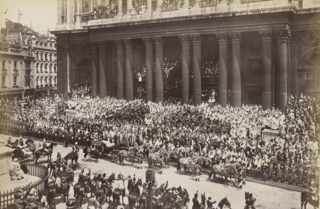
The Diamond Jubilee of Queen Victoria was officially celebrated on 22 June 1897 to mark the occasion of the 60th anniversary of Queen Victoria's accession on 20 June 1837. Queen Victoria was the first British monarch ever to celebrate a Diamond Jubilee.

The coronation of Elizabeth II as queen of the United Kingdom and the other Commonwealth realms took place on 2 June 1953 at Westminster Abbey in London. She acceded to the throne at the age of 25 upon the death of her father, George VI, on 6 February 1952, being proclaimed queen by her privy and executive councils shortly afterwards. The coronation was held more than one year later because of the tradition of allowing an appropriate length of time to pass after a monarch dies. It also gave the planning committees adequate time to make preparations for the ceremony. During the service, Elizabeth took an oath, was anointed with holy oil, was invested with robes and regalia, and was crowned Queen of the United Kingdom, Canada, Australia, New Zealand, South Africa, Pakistan, and Ceylon.

William James Frecklington, known as "W. J." or "Jim", is a maker of carriages.

Ralph Heimans, is an Australian-British contemporary portrait painter based in London, England. He is considered to be "one of today's leading portrait artists". He is best known for his large-scale Royal portraits of Queen Elizabeth II, Charles, Prince of Wales, and Prince Philip, Duke of Edinburgh, along with portraits of leading contemporary cultural figures. In 2014, Heimans was awarded a Member of the Order of Australia for Services to Portraiture.

The Coronation Theatre: Portrait of HM Queen Elizabeth II was painted by Ralph Heimans in 2012 to mark the Diamond Jubilee of Queen Elizabeth II. While the sitting took place in Buckingham Palace, the Queen is portrayed in Westminster Abbey, standing at the centre of the Cosmati pavement where she had been crowned 60 years previously. The mosaic pavement, referred to by Shakespeare as "the floor of heaven", is rich in symbolism and was created to evoke the "eternal pattern of the universe". It has been an integral part of the coronation ceremony since Henry III of England and is where every English monarch has been crowned for the last 900 years.

The state and royal cars of the United Kingdom are kept at the Royal Mews, Buckingham Palace, where a wide range of state road vehicles are kept and maintained. The vehicles also are stored at other royal residences as required.






















